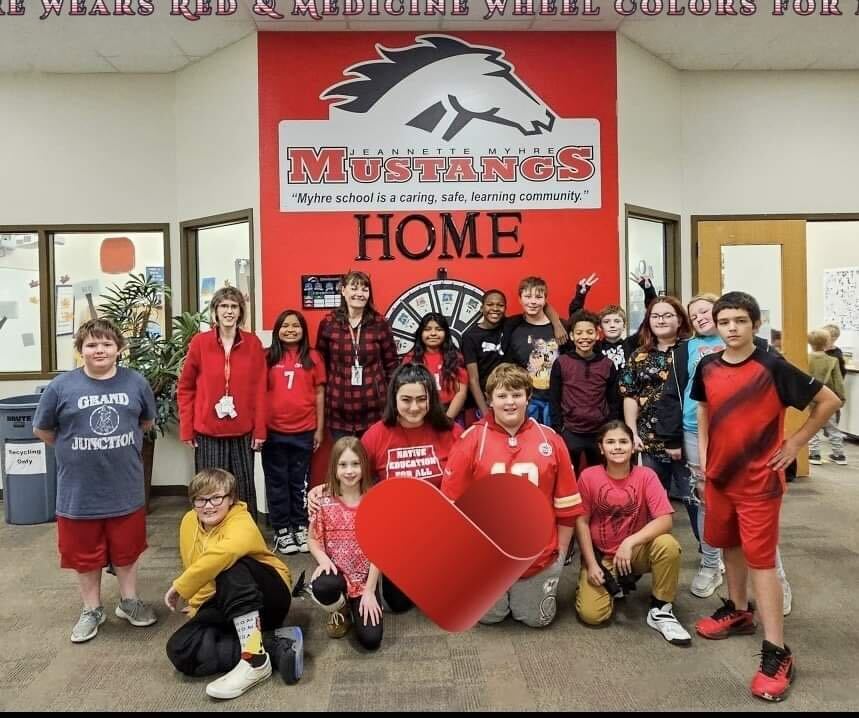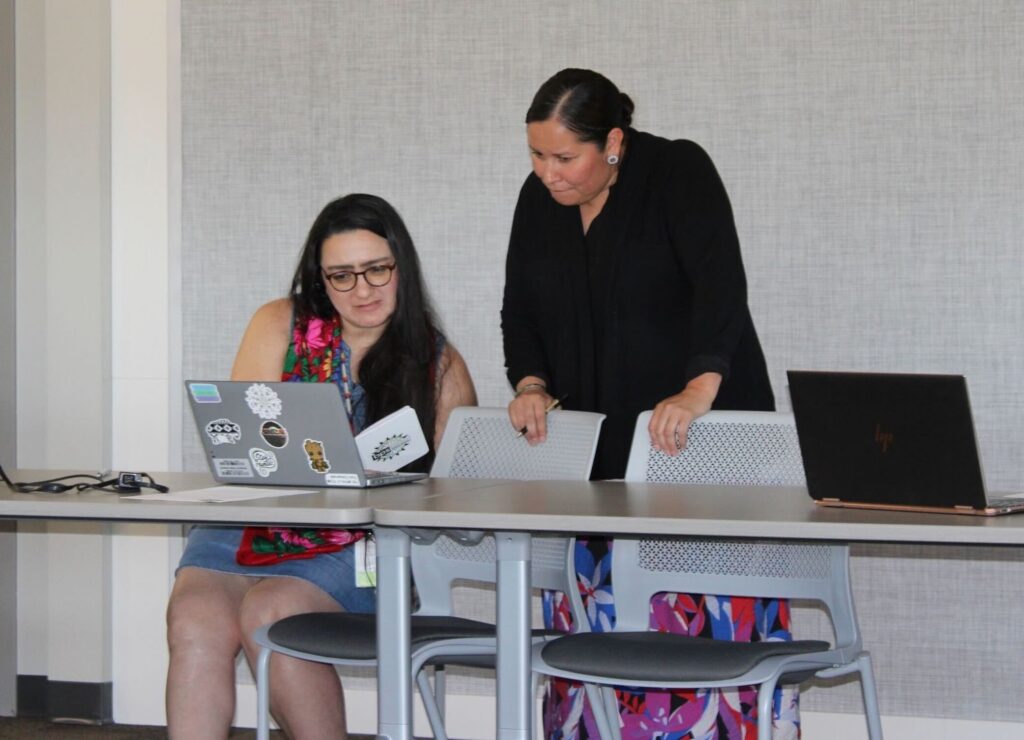Inspired by her grandparents, Tonah Fishinghawk-Chavez proves that caring for the community is an action, not just a word

Tomi Cimarosti spoke at the district’s feather-tying ceremony at Century High School on May 25. (Photo credit/ Adrianna Adame)
When Tomi Cimarosti was 3 years old, she entered the dance circle for the first time. Her grandmother, Standing Rock matriarch Kunshi Agatha, motivated her to pursue her passion, dancing back then. The night before, Agatha stayed up all night to finish her regalia as a sign of support.
“It showed me at a very early age that action can result in some really beautiful experiences,” she said. “So because she encouraged that, she then eventually encouraged my parents, my family and me to continue to dance and learn our language.”
Cimarosti carries that passion for her culture into her role as Bismarck Public School’s Indigenous Education Director. She’s been preparing for the job since she accepted the new role in May. Over the past few months, Cimarosti has attended meetings with the Indigenous Parent Advisory Committee, BPS’s Indigenous Education Department, and other educators across the district.

“I’ve gotten to sit down and meet with quite a few of our principals and leadership within the buildings, just to get an understanding of what it is that they want, what they know, that their students could benefit from,” she said. “And Indigenous students in particular I feel like have had little voice for a very long time.”
Cimarosti, a citizen of the Standing Rock Dakota/Lakota Oyate of the Iháŋktȟuŋwaŋna Yanktonai, wants to focus on building a better relationship between the school district and the community. Most importantly, she said, she wants students to feel loved and valued.
“I think the more we can give kids, parents and leadership the opportunity to truly voice candidly what it is that they feel would be beneficial, I think the closer we can get to that genuine ability to sit down, have honest conversations and celebrate when we find success together,” Cimarosti said.
She has over 20 years of experience working with youth, families, and various local agencies in North Dakota. Originally, Cimarosti planned to go into law enforcement, like her father, who was Chief of Police for the Bureau of Indian Affairs. She received her bachelor’s degree in criminal justice from Minot State University with a minor in psychology in 2010. While in school, she coached students in sports. She said she enjoyed helping kids improve their skills.
Before working with the district she assisted at-risk kids at Charles Hall Youth & Family Services. “I fell in love with working with kids, and seeing there was value to not only gaining experience in working within the at-risk population –– but once I was hired and began my position, I didn’t want to leave, or finish my track toward law and criminal justice in its traditional form.”
“I hope that we can set as much of a foundation for them full of everything that they need to elevate them to where they need to be in life, or where they want to be in life, whatever success looks like for them.”
Tomi Cimarosti- Indigenous Education Director for Bismarck Public Schools
“I got to be a liaison to our kids, ensuring that they had their homework done, make sure they have what they need for test preparation and that sort of thing,” Cimarosti said. “That was a very small-scale connection with the schools.”
In part because of her grandmother’s passing in 2006 and because of her heavy workload, dancing has gone by the wayside in recent years. Though Cimarosti is not currently dancing, her 10-year-old son Vincenzo has been learning about their culture and will be ready when he enters the dance circle. She is happy to pass on her culture and tradition to the next generation and plans to join the circle again.
“I tried re-entering the dance circle multiple times, and it wasn’t the right time for me,” Cimarosti said. “There’s always something going on. I worked an insane amount when I was at Charles Hall. I was always the person to pick up the extra shifts just because I loved being with the kids.”
Prior to becoming the Indigenous Education Director, Cimarosti worked for BPS for the past three years as a Prevention and Relationship Education Program facilitator, behavioral specialist, and family engagement liaison.
“Working with kids pretty much all of my life, they’re near and dear to my heart,” she said. “I hope that we can set as much of a foundation for them full of everything that they need to elevate them to where they need to be in life, or where they want to be in life, whatever success looks like for them.”
In 2018, the district had only one cultural coordinator. Once BPS received more funding, the district expanded the Indigenous Education Department. By adding more cultural coordinators, the department was able to provide further support to Indigenous students.

BPS’s first Indigenous Education Director, Sashay Schettler, focused on implementing North Dakota SB 2304. Gov. Doug Burgum signed the bill into law on April 23, 2021. The bill’s purpose is to teach an American Indian-based curriculum to K-12 students. The bill requires fourth and eighth graders to have Indigenous studies lessons focusing on North Dakota’s federally recognized tribes.
Like her predecessor, Cimarosti would like to keep up the momentum by continuing to incorporate Native-centered curriculum and programs into BPS. As someone who comes from a counseling background, she’d also like to prioritize the mental health of Indigenous students.
“I think mental health is one of the pieces of Indigenous education that we may have not tackled yet,” she said. She is well aware of the historical narrative of historical traumas within school settings, such as boarding schools, which still lingers for many students and families.
Cimarosti said summer has been quiet and she misses seeing the students regularly. Once school begins, she plans to interact with students and educators across the district as much as possible.
“I am looking forward to being engaged and present within the schools as often as I can,” she said. “I don’t want to be stuck behind a desk in an office too much. I know that’s a huge part of the role, to make sure that things are done and the back end of things are set, but the true work is done on the floors; in the hallways, in the cafeterias. I want to meet our kids where they are.”
As director, Cimarosti hopes to make a difference in Native students’ lives. She wants them to know Native resiliency “is woven into our DNA. So whatever it is that they face, they have us,” she said, “They have our department. They have our schools. They have their parents and their grandparents.”
Adrianna Adame
Former Indigenous Democracy Reporter
Location: Bismarck, North Dakota
See the journalist page© Buffalo's Fire. All rights reserved.
This article is not included in our Story Share & Care selection.The content may only be reproduced with permission from the Indigenous Media Freedom Alliance. Please see our content sharing guidelines.
The billboard project is expanding to Oregon
The film tells the story of white buffalo calves on the Turtle Mountain Reservation
Identification not yet made
Dramatic play reveals power of Indigenous stories and community
Thousands peacefully protest







